综合英语教程chinesefood
- 格式:ppt
- 大小:1.03 MB
- 文档页数:84

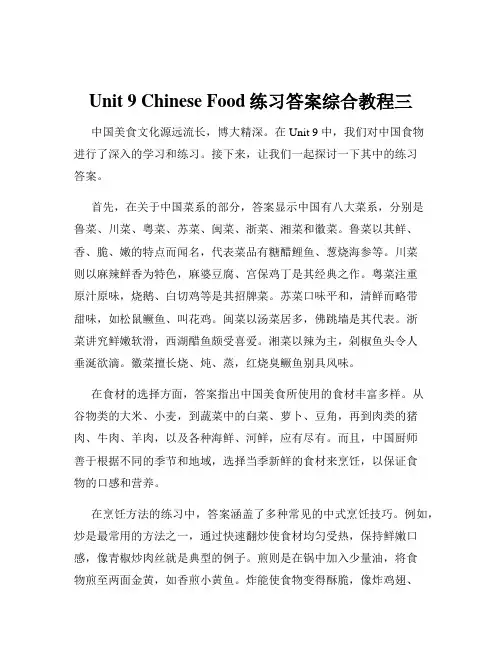
Unit 9 Chinese Food练习答案综合教程三中国美食文化源远流长,博大精深。
在 Unit 9 中,我们对中国食物进行了深入的学习和练习。
接下来,让我们一起探讨一下其中的练习答案。
首先,在关于中国菜系的部分,答案显示中国有八大菜系,分别是鲁菜、川菜、粤菜、苏菜、闽菜、浙菜、湘菜和徽菜。
鲁菜以其鲜、香、脆、嫩的特点而闻名,代表菜品有糖醋鲤鱼、葱烧海参等。
川菜则以麻辣鲜香为特色,麻婆豆腐、宫保鸡丁是其经典之作。
粤菜注重原汁原味,烧鹅、白切鸡等是其招牌菜。
苏菜口味平和,清鲜而略带甜味,如松鼠鳜鱼、叫花鸡。
闽菜以汤菜居多,佛跳墙是其代表。
浙菜讲究鲜嫩软滑,西湖醋鱼颇受喜爱。
湘菜以辣为主,剁椒鱼头令人垂涎欲滴。
徽菜擅长烧、炖、蒸,红烧臭鳜鱼别具风味。
在食材的选择方面,答案指出中国美食所使用的食材丰富多样。
从谷物类的大米、小麦,到蔬菜中的白菜、萝卜、豆角,再到肉类的猪肉、牛肉、羊肉,以及各种海鲜、河鲜,应有尽有。
而且,中国厨师善于根据不同的季节和地域,选择当季新鲜的食材来烹饪,以保证食物的口感和营养。
在烹饪方法的练习中,答案涵盖了多种常见的中式烹饪技巧。
例如,炒是最常用的方法之一,通过快速翻炒使食材均匀受热,保持鲜嫩口感,像青椒炒肉丝就是典型的例子。
煎则是在锅中加入少量油,将食物煎至两面金黄,如香煎小黄鱼。
炸能使食物变得酥脆,像炸鸡翅、炸薯条深受大众欢迎。
蒸能最大程度地保留食物的营养成分,如清蒸鱼。
煮可以让食物变得软烂,如煮面条、煮饺子。
炖和煲则能使食材的味道充分融合,如红烧肉、冬瓜排骨煲。
在调味方面,答案强调了中国美食对调味料的巧妙运用。
盐是基本的调味品,用于调整食物的咸淡。
糖不仅能增加甜味,还能起到提鲜的作用。
酱油赋予食物色泽和独特的酱香,醋则增添酸味和去腥解腻。
辣椒、花椒为食物带来麻辣的刺激,葱姜蒜则能去腥增香。
此外,还有八角、桂皮、香叶等香料,为菜肴增添丰富的味道层次。
在饮食文化的练习题中,答案阐述了中国饮食文化中的一些重要观念。
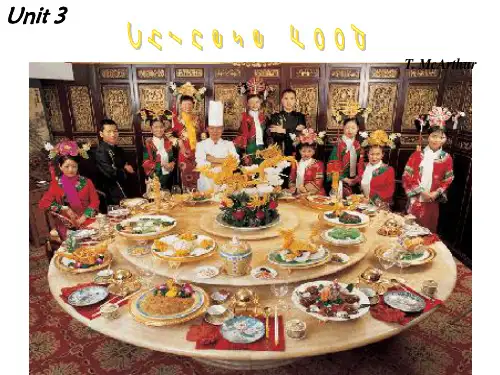



Unit 9 Chinese FoodKey to the ExercisesText comprehensionI. Decide which of the following best states the main idea of the passage.B(This essay is by and large an illustration of a proposition raised by Kenneth Lo thatfood will determine one's physical strength and ultimately one's spiritual and moral fiber and well-being. Its aim and conclusion rest with the philosophy expressed in Chinese food.)II. Judge, according to the text, whether the following statements are true or false.1.T (Refer to Paragraph 1.)2. T (Refer to Paragraph 2.)3. T (Refer to Paragraph 6.)4. F (Refer to Paragraph 7. According to Helen Burke, the cooking itself takes only 10% of the actual preparation but it is not a simple matter as indicated by the percentage of time it consumes.)5. T (Refer to Paragraph 9.)III. Answer the following questions.1.Food and eating, according to Kenneth Lo, determines not only one's physical healthbut also one's spiritual and moral soundness and his ultimate well-being.2. Refer to Paragraphs 2, 3 and 4. According to the author, many people in the West are gourmets and gluttons, while a large number of others are pretty indifferent to food. On the contrary, Fu Tong, a London restaurateur, maintains that to Chinese people food is of primary importance and is one of the ecstasies of life. Also, when they go to a restaurant, Westerners care more about the table than the food, while the Chinese aim to eat with a capital E, or take the food with the utmost earnest.3. Refer to Paragraph 5. Literally, Chinese food is ubiquitous. Chinese restaurants have sprung up almost everywhere in the world. At the root of the phenomenal rise of Chinese food in the world is a strong interest in Chinese food in the West. There is an increase in sensuality in the Western world and coincidentally Chinese food is very sensual in its combination of color, texture and taste.4. Refer to Paragraphs 7 and 8. For Chinese people, the traditional high-quality Chinese meal is a serious matter. It is fastidiously prepared and fastidiously enjoyed. Both thepreparation and enjoyment of a Chinese meal can last hours and make a sharedtheof challenge the meet only not must meal The planned. well is which experiencepalate but also that of the eye.5. Refer to Paragraph 9. A good traditional Chinese meal must be well planned and balanced in order to meet the demand of the palate and the eye alike. So, according to Emily Hahn, there is moral excellence in good cooking, which implies the combination of all life, all action and all knowledge. So important is a meal that it is not simply the product of a recipe; it expresses the basic assumptions of life, among which is harmony and balance.IV. Explain in your own words the following sentences.1.Food to us Chinese is one of the greatest joys in life: it is thought about before being prepared; it is treated with lots of love and care while being prepared; and when it is ready, a great deal of time is devoted to enjoying it.2. The main reason for the sudden and tremendous popularity of Chinese food throughout the whole Western world lies in two facts: one is the increased desire for sensual pleasures (which is abundant in Chinese food) and freedom from age-old customs in the West; the other is the notion of physical pleasure provided by Chinese food, which is always ready to satisfy the taste of the eater.Structural analysis of the textParagraphs 7-9 constitute the third part of the text.Paragraph 7: The traditional quality Chinese meal is a serious matter, fastidiously prepared and fastidiously enjoyed.Paragraph 8: The enjoyment must match the preparation.Paragraph 9: The smooth harmonies and piquant contrasts in Chinese food are an expression of basic assumptions about life itself.Rhetorical features of the text1. All these have become much more part and parcel of the average person's life? (Paragraph 6)2. Meat and fish, solids and soups, sweet and sour sauces? (Paragraph 8)Vocabulary exercisesI. Explain the underlined part in each sentence in your own words.1. emotional strength to do what one believes to be right2. material used to produce power; sth. used to keep the body functioning3. lower-class type4. a number of dishes that are served one after another in an orderly way5. by themselvesII. Fill in the blank in each sentence with a word taken from the box in its appropriate form.1. fastidious2. ecstasies3. lavish4. elusive5. phenomenal6. proceeding7. enterprise 8. contrivedIII. Fill in the blanks with the appropriate forms of the given words.1. disregard2. authoritative3. ubiquity4. desirable5. piquancy6. ceremonially7. gluttonous 8. derivationIV. Fill in the blank(s) in each sentence with an appropriate phrasal verb or collocation taken from the text.1. come off2. conform to3. derives/derived, from4. attend to5. sprung up6. came about7. proceed with8. lavishing ... onGive a synonym or an antonym of the word underlined in each sentence in the sense V. it is used.Antonym: distantly (indifferently) 1.Synonym: epicure 2.Synonym: fundamental (primary, principal) 3.Antonym: produce (make) 4.Synonym: affirm (state)5.Synonym: mix (intermingle, combine) 6.Synonym: change (modify, adjust) 7.Synonym: provocative (sharp, pungent) 8.Explain the underlined phrasal verbs in your own words. VI.1.explains2. accidentally founddiscuss with 3.4. start5. played a prominent role in6. think about it carefully7. consumed part of8. interruptingGrammar exercisesI.Combine the sentences in each set into one, beginning with the words given.1. Lev Tolstoy, a great Russian writer, was born in 1828 and died in 1910.2. My proposal that we should import more equipment from abroad is to be discussed at the meeting.3. The news that she is invited to the party is very encouraging.4. The Canadian surgeon Dr. Norman Bethune, a great international fighter, laid down his life for the Chinese revolution.5. In spite of the fact that they worked day and night on the project, they failed to find out the mechanism of the disease.6. The announcement that all flights were cancelled because of bad weather greatly distressed the waiting passengers.7. Mike, the best mechanic in the garage, worked on my car.8. The amateur boat-builder was constructing a simple model, a small outboard cruiser of conventional design.II. Improve the following sentences by using appositive clauses.1.Our word tobacco comes from the Spanish word tobaco, a word which means cigarin the Arawak Indian language. (An appositive may repeat a noun for the sake of clarity and emphasis.)2. Columbus's crew was astonished to find the Arawaks puffing on huge cigars in Hispaniola, an island which is now divided between Haiti and the Dominican Republic.3. The cigars were made from Nicotiana tobacum, a hybrid of two wild plants first grown in Peru and Bolivia.4. This tobacco from Hispaniola was not the kind smoked by the other Indians of North America, habitual users of tobacco, also.5. This second and much more widely used kind of tobacco was Nicotiana rustica, a hybrid that is native only to the western slopes of the Andes.6. From here its cultivation and use spread into North America at about the same time as the cultivation of maize, a staple grain crop.7. Archaeologists find the first pipes among Indian artifacts at the level that they find the first evidence of maize cultivation, a fact which suggests that the Indians learned to smoke and to grow corn at the same time.8. This tobacco was so strong that the Algonkians mixed it with sumac leaves and the inner bark of the dogwood and called it kinnikinnik, a word meaning hat which ismixed.9. Most Indians favoured pipes, some ate tobacco leaves, some drank tobacco, and still others preferred cigarettes, shredded tobacco wrapped in corn husks.10. Drinking tobacco became popular in Elizabethan England after 1565, the year the leaf was first imported from the West Indies.III. Complete each sentence with what you think the most appropriate of the four choices given.1.C (When the antecedent contains such, the relative word is as.)2. B (Eye means he power of seeing; appreciative or discriminating visual perception.)3. D4. A (In the structure too + adj. + to, we use a/an + n. after the adjective.)5. B (Machinery is a collective noun.)6. A (ear = attention, heed)7. C (brains = intellectual power, intelligence)8. BIV. Rewrite the following sentences using the words in brackets.1.He was less frightened than hurt.2. Their room is no bigger than ours.3. George did more work than anyone else.4. Dick's behavior is more courteous than Bob's.5. I paid three times more for the food than they did. (As much as and as many as are equivalent to more ?than when they are premodified by a times-phrase.)6. A collection of facts cannot be called science any more than a pile of bricks can be called a house.7. A whale is no more a fish than a horse is.8. He is more of a sportsman than his brother.V. Translate the following into English, using the expressions in brackets.1.That noise is more than I can bear.2. We are more than happy to help you in any way we can.3. No less than a thousand people participated in the marathon.4. He is no more interested in chemistry than his brother is.5. It is more a poem than a picture.He was accused of no less a crime than high treason.6.VI. Make sentences of your own after the sentences given below, keeping the italicizedparts in your sentences.1. e.g. He never remembered to have known such weariness as he felt now.The explorer took only such men and things as he really needed into the jungle withhim.2. e.g. He is not just an actor but also a great writer.She not just sings like an angel, but also dances divinely.Translation exercisesTranslate the following sentences into Chinese.I.决定他们体力直至情操气节、健康安乐的东西,又怎能不关心呢?1.事实上,人们颇有理由可以说,中国食品已经成为当今唯一真正意义上的国际性食品。
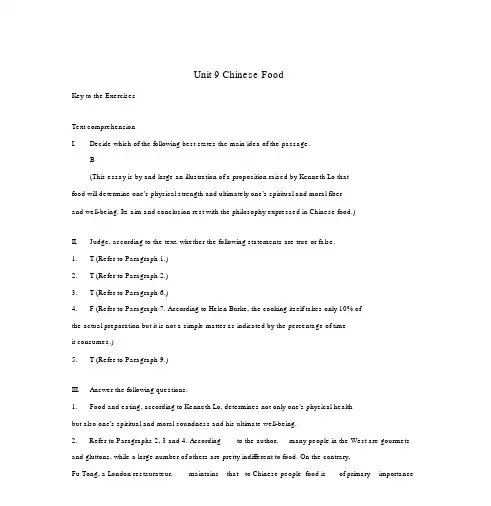
Unit 9 Chinese FoodKey to the ExercisesText comprehensionI.Decide which of the following best states the main idea of the passage.B(This essay is by and large an illustration of a proposition raised by Kenneth Lo thatfood will determine one's physical strength and ultimately one's spiritual and moral fiberand well-being. Its aim and conclusion rest with the philosophy expressed in Chinese food.)II.Judge, according to the text, whether the following statements are true or false.1.T (Refer to Paragraph 1.)2.T (Refer to Paragraph 2.)3.T (Refer to Paragraph 6.)4. F (Refer to Paragraph 7. According to Helen Burke, the cooking itself takes only 10% ofthe actual preparation but it is not a simple matter as indicated by the percentage of timeit consumes.)5.T (Refer to Paragraph 9.)III.Answer the following questions.1.Food and eating, according to Kenneth Lo, determines not only one's physical healthbut also one's spiritual and moral soundness and his ultimate well-being.2.Refer to Paragraphs 2, 3 and 4. According to the author, many people in the West are gourmets and gluttons, while a large number of others are pretty indifferent to food. On the contrary,Fu Tong, a London restaurateur,maintains that to Chinese people food is of primary importanceand is one of the ecstasies of life. Also, when they go to a restaurant, Westerners caremore about the table than the food, while the Chinese aim to eat with a capital E, or takethe food with the utmost earnest.3.Refer to Paragraph 5. Literally, Chinese food is ubiquitous. Chinese restaurants havesprung up almost everywhere in the world. At the root of the phenomenal rise of Chinese foodin the world is a strong interest in Chinese food in the West. There is an increase in sensualityin the Western world and coincidentally Chinese food is very sensual in its combination ofcolor, texture and taste.4.Refer to Paragraphs 7 and 8. For Chinese people, the traditional high-quality Chinese mealis a serious matter. It is fastidiously prepared and fastidiously enjoyed. Both the preparation and enjoyment of a Chinese meal can last hours and make a shared experience which is well planned. The meal must not only meet the challenge of the palate but also that of the eye.5.Refer to Paragraph 9. A good traditional Chinese meal must be well planned and balancedin order to meet the demand of the palate and the eye alike. So, according to Emily Hahn, there is moral excellence in good cooking, which implies the combination of all life, all actionand all knowledge. So important is a meal that it is not simply the product of a recipe;it expresses the basic assumptions of life, among which is harmony and balance.IV. Explain in your own words the following sentences.1.Food to us Chinese is one of the greatest joys in life: it is thought about before beingprepared; it is treated with lots of love and care while being prepared; and when it is ready, a great deal of time is devoted to enjoying it.2.The main reason for the sudden and tremendous popularity of Chinese food throughout thewhole Western world lies in two facts: one is the increased desire for sensual pleasures (which is abundant in Chinese food) and freedom from age-old customs in the West; the other is thenotion of physical pleasure provided by Chinese food, which is always ready to satisfy thetaste of the eater.Structural analysis of the textParagraphs 7-9 constitute the third part of the text.Paragraph 7: The traditional quality Chinese meal is a serious matter, fastidiouslyprepared and fastidiously enjoyed.Paragraph 8: The enjoyment must match the preparation.Paragraph 9: The smooth harmonies and piquant contrasts in Chinese food are an expressionof basic assumptions about life itself.Rhetorical features of the text1.All these have become much more part and parcel of the average person's life? (Paragraph 6)2.Meat and fish, solids and soups, sweet and sour sauces? (Paragraph 8)Vocabulary exercisesI.Explain the underlined part in each sentence in your own words.1.emotional strength to do what one believes to be right2.material used to produce power; sth. used to keep the body functioning3.lower-class type4. a number of dishes that are served one after another in an orderly way5.by themselveswith a word taken from the box in its appropriate form. II.Fill in the blank in each sentence1. fastidious2. ecstasies3. lavish4. elusive5. phenomenal6. proceeding7. enterprise8. contrivedIII. Fill in the blanks with the appropriate forms of the given words.1. disregard2. authoritative3. ubiquity4. desirable5. piquancy6. ceremonially7. gluttonous8. derivationIV.Fill in the blank(s) in each sentence with an appropriate phrasal verb or collocation taken from the text.e off2.conform to3.derives/derived, from4.attend to5.sprung up6.came about7.proceed withvishing ... onV.Give a synonym or an antonym of the word underlined in each sentence in the sense it is used.1.Antonym: distantly (indifferently)2.Synonym: epicure3.Synonym: fundamental (primary, principal)4.Antonym: produce (make)5.Synonym: affirm (state)6.Synonym: mix (intermingle, combine)7.Synonym: change (modify, adjust)8.Synonym: provocative (sharp, pungent)VI. Explain the underlined phrasal verbs in your own words.1.explains2.accidentally found3.discuss with4.start5.played a prominent role in6.think about it carefully7.consumed part of8.interruptingGrammar exercisesbine the sentences in each set into one, beginning with the words given.1. Lev Tolstoy, a great Russian writer, was born in 1828 and died in 1910.2.My proposal that we should import more equipment from abroad is to be discussed atthe meeting.3.The news that she is invited to the party is very encouraging.down his life 4.The Canadian surgeon Dr. Norman Bethune, a great international fighter,laidfor the Chinese revolution.5.In spite of the fact that they worked day and night on the project, they failed tofind out the mechanism of the disease.6.The announcement that all flights were cancelled because of bad weather greatly distressed the waiting passengers.7.Mike, the best mechanic in the garage, worked on my car.8.The amateur boat-builder was constructing a simple model, a small outboard cruiserof conventional design.II. Improve the following sentences by using appositive clauses.1. Our word tobacco comes from the Spanish word tobaco, a word which means "cigar" in the Arawak Indian language. (An appositive may repeat a noun for the sake of clarity and emphasis.)2.Columbus's crew was astonished to find the Arawaks puffing on huge cigars in Hispaniola,an island which is now divided between Haiti and the Dominican Republic.3.The cigars were made from Nicotiana tobacum, a hybrid of two wild plants first grown inPeru and Bolivia.4.This tobacco from Hispaniola was not the kind smoked by the other Indians of North America,habitual users of tobacco, also.5.This second and much more widely used kind of tobacco was Nicotiana rustica, a hybrid thatis native only to the western slopes of the Andes.6.From here its cultivation and use spread into North America at about the same time as thecultivation of maize, a staple grain crop.7.Archaeologists find the first pipes among Indian artifacts at the level that theyfind the first evidence of maize cultivation, a fact which suggests that the Indianslearned to smoke and to grow corn at the same time.8.This tobacco was so strong that the Algonkians mixed it with sumac leaves and theinner bark of the dogwood and called it kinnikinnik, a word meaning "that which is mixed."9.Most Indians favoured pipes, some ate tobacco leaves, some drank tobacco, and still otherspreferred cigarettes, shredded tobacco wrapped in corn husks.10."Drinking tobacco" became popular in Elizabethan England after 1565, the year the leafwas first imported from the West Indies.III. Complete each sentence with what you think the most appropriate of the four choices given.1.C (When the antecedent contains such, the relative word is as.)2. B (Eye means "the power of seeing; appreciative or discriminating visual perception.")3. D4. A (In the structure too + adj. + to, we use a/an + n. after the adjective.)5. B (Machinery is a collective noun.)6. A (ear = attention, heed)7. C (brains = intellectual power, intelligence)8. BIV. Rewrite the following sentences using the words in brackets.1.He was less frightened than hurt.2.Their room is no bigger than ours.3.George did more work than anyone else.4.Dick's behavior is more courteous than Bob's.5.I paid three times more for the food than they did. (As much as and as many as are equivalent to more ?than when they are premodified by a times-phrase.)6. A collection of facts cannot be calledscience any more than a pile of bricks can be calleda house.7. A whale is no more a fish than a horse is.8.He is more of a sportsman than his brother.V.Translate the following into English, using the expressions in brackets.1. That noise is more than I can bear.2. We are more than happy to help you in any way we can.3.No less than a thousand people participated in the marathon.4.He is no more interested in chemistry than his brother is.5.It is more a poem than a picture.6.He was accused of no less a crime than high treason.。
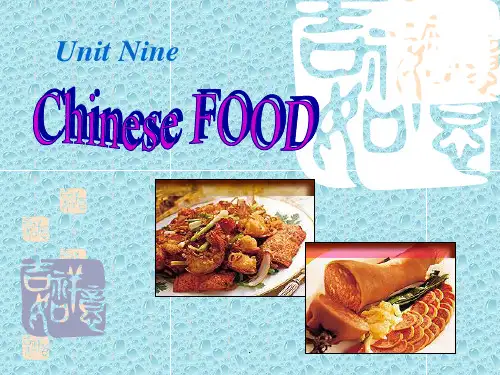
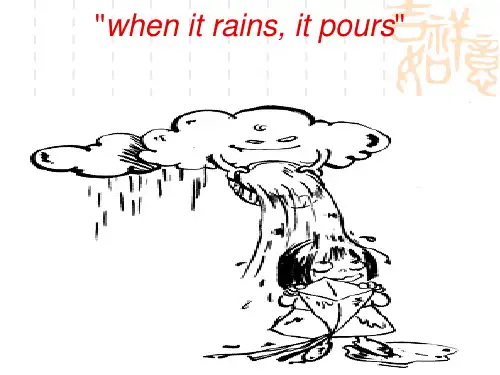
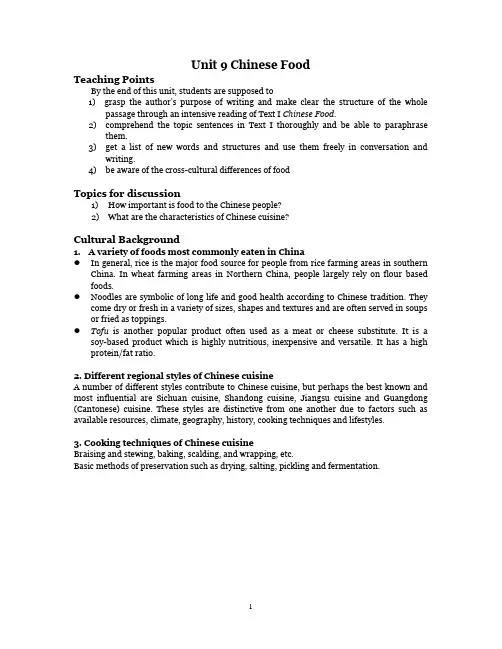
Unit 9 Chinese FoodTeaching PointsBy the end of this unit, students are supposed to1)grasp the author’s purpose of writing and make clear the structure of the wholepassage through an intensive reading of Text I Chinese Food.2)comprehend the topic sentences in Text I thoroughly and be able to paraphrasethem.3)get a list of new words and structures and use them freely in conversation andwriting.4)be aware of the cross-cultural differences of foodTopics for discussion1)How important is food to the Chinese people?2)What are the characteristics of Chinese cuisine?Cultural Background1. A variety of foods most commonly eaten in China●In general, rice is the major food source for people from rice farming areas in southernChina. In wheat farming areas in Northern China, people largely rely on flour based foods.●Noodles are symbolic of long life and good health according to Chinese tradition. Theycome dry or fresh in a variety of sizes, shapes and textures and are often served in soups or fried as toppings.●Tofu is another popular product often used as a meat or cheese substitute. It is asoy-based product which is highly nutritious, inexpensive and versatile. It has a high protein/fat ratio.2. Different regional styles of Chinese cuisineA number of different styles contribute to Chinese cuisine, but perhaps the best known and most influential are Sichuan cuisine, Shandong cuisine, Jiangsu cuisine and Guangdong (Cantonese) cuisine. These styles are distinctive from one another due to factors such as available resources, climate, geography, history, cooking techniques and lifestyles.3. Cooking techniques of Chinese cuisineBraising and stewing, baking, scalding, and wrapping, etc.Basic methods of preservation such as drying, salting, pickling and fermentation.Text IChinese FoodT. McArthurGlobal ReadingI. Text AnalysisThis article, which is written by a foreigner, provides us with a foreign perspective to examine our culture, though on a seemingly trivial aspect — our food. But all elements of a culture are actually of equal significance, so any of them can serve as a stand we set our first step on. If you haven’t started your journey to discover your own culture, then let yourself be pushed by this article and take it as your first step. At the end of this journey, you may either love your culture more, or less, but one thing is sure, that your feeling toward your culture will be more real and will be based upon a much broadened view.II. Structural AnalysisThis text can be divided into three parts:Paragraphs 1-4: The first part discusses the difference in Chinese and Western attitudes towards food.Paragraphs 5-6: The second part explains how Chinese food has become an international food.Paragraphs 7-9: The third part elaborates on the nature of Chinese food.The topic sentence of Paragraphs 7-9:Paragraph 7: The traditional high-quality Chinese meal is a serious matter, fastidiously prepared and fastidiously enjoyed.Paragraph 8: The enjoyment must match the preparation.Paragraph 9: The smooth harmonies and piquant contrasts in Chinese food are an expression of basic assumptions about life itself.Ⅲ. Rhetorical FeaturesIn this essay, alliteration is utilized here and there. Here are some examples: “Many people in the West are gourmets and others are g luttons, …”; “… to making you a saint or a s inner?”; “…everywhere from Hong Kong to Honolulu to Ho boken to Hudderfield.” The underlined parts show repetition of the first sound or letter of a succession of words, which helps to convey a sort of melodious quality, thus making those words sound more pleasing and impressive.Other examples of alliteration in the essay:1. “… all these have become much more a part and p arcel of the average person’s life…”(Paragraph 6)2. “Meat and fish, solids and soups, sweet and sour sauces, …” (Paragraph 8)Detailed ReadingQuestions1. How important is food and eating, according to Kenneth Lo? (Paragraph 1)Food and eating, according to Kenneth Lo, determines not only one’s physical health but also one’s spiritual and moral soundness and his ultimate well-being.2. How do the Chinese and westerners differ in their attitudes towards food? (Paragraphs 2, 3 and 4)According to the author, many people in the West are gourmets and others are gluttons, while a large number of them are pretty indifferent to food. On the other hand, Fu Tong, a London restaurateur, maintains that food is of primary importance and one of the ecstasies of life. When they go to a restaurant, Westerners care more about the table than the food, while the Chinese aims to eat with a capital E, or take the food with the utmost earnest.3. Why does the author say that Chinese food is the only truly international food? (Paragraph 5)Literally, Chinese food is ubiquitous. Chinese restaurants have sprung up almost everywhere in the world. At the root of the phenomenal rise of Chinese food in the world, there is a strong interest in Chinese food in the West. There is an increase in the sensuality in the Western world and coincidentally, Chinese food is very sensual in its combination of color, texture and taste.4. Why does the author compare a proper Chinese meal to a religious ceremony? (Paragraphs 7 and 8)For the Chinese people, the traditional high-quality Chinese meal is a serious matter. It is fastidiously prepared and fastidiously enjoyed. Both the preparation and enjoyment of a Chinese meal can last hours and make a shared experience which is well planned. The meals must not only meet the challenge of the palate but also that of the eyes.5. How does Chinese food express the basic assumptions of life? (Paragraph 9)A good traditional Chinese meal must be well planned and balanced in order to meet thedemand of the palate and the eyes alike. So, according to Emily Hahn, there is moral excellence in good cooking, which implies the combination of all life, all action and all knowledge. So important is a meal that it does not mean the product of recipe itself; it express the basic assumption of life one of which is harmony and balance.Text IIChinese Food in AmericaCorinna LotharLead-in QuestionsWhat are the most popular Chinese dishes among foreign visitors as far as you know? Any thing they don’t like about Chinese cooking?Main ideaSay No to Western Fast Food introduces a new phenomenon that is happening around China now. It implies the harm the fast food brings to people. On the other hand, it doesn’t deny the advantage of eating in the fast food restaurants. The article compares fast food with Chinese traditional food, emphasizing the significance of keeping food tradition in China. Notes1.About the author: Fortune Cookie Chronicles, subtitled Adventures in the Worldof Chinese Food, by Jennifer 8. Lee, a New York Times reporter for the Metro section.2.Jennifer 8. Lee (Paragraph 1) Jennifer 8. Lee was born in New York City andgraduated from Hunter College High School and Harvard College. She interned at The Washington Post, The Wall Street Journal, The Boston Globe, Newsday and The New York Times while working on her applied mathematics and economics degree and writing for The Harvard Crimson. She joined the Times in 2001, one anda half years after graduating from Harvard. Lee was not given a middle name at birthand chose her own middle name later.She chose "8" as a teenager because of the prevalence of her first name.It was in her teen years that she also began a life-long obsession with food. For many Chinese, the number eight symbolizes prosperity and good luck. Lee wrote a book about the history of Chinese food in the USA and around the world, titled The Fortune Cookie Chronicles,documenting the process on her blog. Warner Books editor Jonathan Karp struck a deal with Lee to write a book about "how Chinese food is more all-American than apple pie."3.Powerball lottery (Paragraph 2) Powerball is an American lottery game soldthrough U.S. lotteries as a shared jackpot pool game. It is coordinated by the Multi-State Lottery Association (MUSL), a non-profit association formed by an agreement with member lotteries. Powerball is drawn Wednesdays and Saturdays.4.General Tso's chicken (Paragraph 4) General Tso may refer to Zuo Zongtang (左宗棠, 1812-1885), a Qing Dynasty general from Hunan.. General Tso's chicken is a sweet and spicy deep-fried chicken dish that is popularly served in American and Canadian Chinese restaurants where it is erroneously considered Hunan cuisine.The origins of the dish are unclear. The dish was previously largely unknown in China. Thus, General Tso's Chicken is most likely an American invention in the history of American-Chinese food.5.Colonel Sanders(Paragraph 4) Colonel Harland Sanders, (1890-1980), was anAmerican entrepreneur who founded Kentucky Fried Chicken (KFC). His image is omnipresent in the chain's advertising and packaging, and his name is sometimes used as a synonym for the KFC product or restaurant itself.6.“waves of Chinese continued to wash up on the shores”(Paragraph 7)Chinese immigrants arrived in the US in large numbers beginning with the mid-19th century worked as laborers, particularly on the transcontinental railroad, such as the Central Pacific Railroad, and the mining industry, and suffered racial discrimination for a long time.7.The Chinese Exclusion Act of 1882(Paragraph 7) The Chinese Exclusion Actwas a United States federal law passed on May 6, 1882, following revisions made in 1880 to the Burlingame Treaty of 1868. Those revisions allowed the U.S. to suspend immigration, and Congress subsequently acted quickly to implement the suspension of Chinese immigration, a ban that was intended to last 10 years.8.Szechuan (Paragraph 9) This is the Romanization of 四川using the Wade-Gilessystem rather than the Pinyin system, which renders it Sichuan.9.kosher ducks (Paragraph 10) The word “kosher” means proper or fit for Jews. Thisis because it relates to the kosher dietary law. They are safe to consume and sometimes used as ingredients to produce additional food items. Previously, most kosher foods were made in the family kitchen or in a store or small factory in the community. At that time, it was simple to know if the product was kosher or not.Sometimes, even rabbis used to supervise the purity of the product.Questions for Discussion1.How can the reader understand and enjoy “a delicious sense of humor and irony” of Jennifer 8. Lee ?2. Why do the stories Miss Lee gleaned and spread sound so convincing?3. What is one possible philosophical notion that helps to constitute the driving force in developing Chinese food in America?4. What is the fact used to tell the reader that Jews in America like Chinese food?Key to Questions for Discussion1. In her “Fortune Cookie Chronicles,” subtitled “Adventures in the World of Chinese Food,”Jennifer 8. Lee writes with humor and irony and “delights the reader with tales about Chinese food in America, and its sometimes hilarious origins”, which is really delicious. In addition, Miss Lee adds a social and cultural dimension to the Chinese-American cuisine, seasoning it well with personal anecdotes, which is also delicious. “A delicious sense of humor and irony” may be interpreted as a sort of “transferred epithet”.2. The stories Miss Lee gleaned and spread are not fairy-tales, fictitious or improbable stories, but true stories based on first hand experiences “over hill and dale, ocean and mountain,from town to village” throughout the United States, China, and Europe. That’s why they sound so convincing.3. One possible philosophical notion that helps to constitute the driving force in developing Chinese food in America is the strong desire to adapt and incorporate Chinese cooking, principally its indigenous ingredients and cooking techniques, to local tastes and ingredients.4. In Kaifeng, China, when asked why Jews in America were so fond of Chinese food, an old Jewish woman answered, “Because Chinese food tastes good.”Memorable QuotesTell me what you eat, and I will tell you what you are.—Anthelme Brillat-SavarinI do not want my house to be walled in on all sides and my windows to bestuffed. I want the cultures of all the lands to be blown about my house asfreely as possible. But I refuse to be blown off my feet by any.—Mahatma GandhiJean Anthelme Brillat-Savarin (1755-1826) was a French lawyer and politician, and gained fame as an epicure and gastronome.Mahatma Gandhi (1869-1948) was the pre-eminent political and ideological leader of India during the Indian independence movement. Gandhi is often referred to as Mahatma Gandhi, which means Great Soul. He is officially honoured in India as the Father of the Nation.Questions for DiscussionCan you discuss with your fellow classmates about your eating habits? Is there any particular kind of food you won’t try? What’s the reason for it? And what can these habits tell about you? What do you think of being an adventurous eater? Do you believe food can inform us of a culture?。
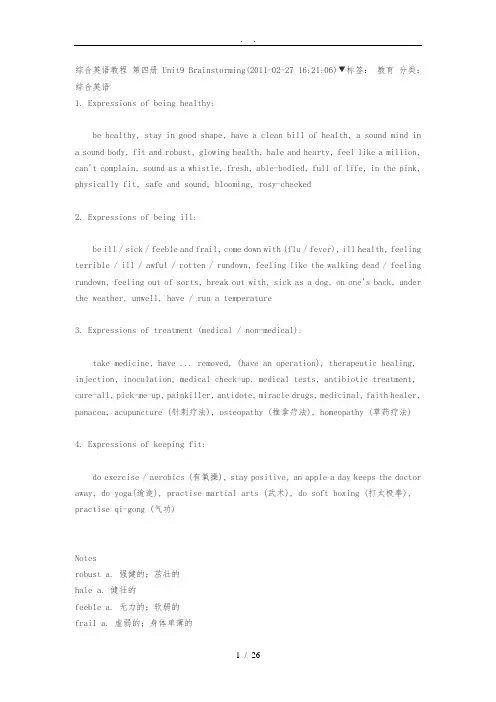
综合英语教程第四册 Unit9 Brainstorming(2011-02-27 16:21:06)▼标签:教育分类:综合英语1. Expressions of being healthy:be healthy, stay in good shape, have a clean bill of health, a sound mind in a sound body, fit and robust, glowing health, hale and hearty, feel like a million, can't complain, sound as a whistle, fresh, able-bodied, full of life, in the pink, physically fit, safe and sound, blooming, rosy-cheeked2. Expressions of being ill:be ill / sick / feeble and frail, come down with (flu / fever), ill health, feeling terrible / ill / awful / rotten / rundown, feeling like the walking dead / feeling rundown, feeling out of sorts, break out with, sick as a dog, on one's back, under the weather, unwell, have / run a temperature3. Expressions of treatment (medical / non-medical):take medicine, have ... removed, (have an operation), therapeutic healing, injection, inoculation, medical check-up, medical tests, antibiotic treatment, cure-all, pick-me-up, painkiller, antidote, miracle drugs, medicinal, faith healer, panacea, acupuncture (针刺疗法), osteopathy (推拿疗法), homeopathy (草药疗法)4. Expressions of keeping fit:do exercise / aerobics (有氧操), stay positive, an apple a day keeps the doctor away, do yoga(逾迦), practise martial arts (武术), do soft boxing (打太极拳), practise qi-gong (气功)Notesrobust a. 强健的;茁壮的hale a. 健壮的feeble a. 无力的;软弱的frail a. 虚弱的;身体单薄的disability n. 无能力;无力therapeutic a. 有疗效的;有益健康的antibiotic a. 抗生素的,抗菌的painkiller n. 止痛药antidote n. 解毒药medicinal a. 药用的;有疗效的palliative n. 缓和物acupuncture n. 针刺疗法osteopathy n. 推拿疗法homeopathy n. 草药疗法aerobics n. 有氧运动(操)remedy n. 治疗;药品"Few things in life are as positive as food, or are taken as intimately and completely by the individual. One can listen to music, but the sound may enter in one ear and go out through the other; one may listen to a lecture or conversation, and day-dream about many other things; one may attend to matters of business, and one's heart or interest may be altogether elsewhere ... In the matter of food and eating however one can hardly remain completely indifferent to what one is doing for long. How can one remain entirely indifferent to something which is going to enter one's body and become part of oneself? How can one remain indifferent to something which will determine one's physical strength and ultimately one's spiritual and moral fibre and well-being?" Kenneth Lo---- Kenneth Lo生活中很少有几样东西像食物一样实在,像食物一样与我们息息相关的了。
Unit 9 Chinese Food练习答案综合教程三Chinese cuisine is renowned around the world for its diversity, flavors, and culinary traditions. In this unit, we will explore the different aspects of Chinese food, including its history, regional variations, and cultural significance.1. History of Chinese FoodChinese cuisine has a rich history that spans thousands of years. It has evolved over time and is influenced by various factors such as geography, weather conditions, and cultural exchanges. The earliest known Chinese cookbook dates back to the 5th century BC during the Warring States period. It is called "The Essential Arts of Peace" and contains recipes for various dishes.The development of Chinese cuisine can be traced back to the Zhou Dynasty (1046-256 BC), when different cooking techniques and seasonings were introduced. The use of soy sauce, vinegar, and various spices became common in Chinese cooking during this time.2. Regional VariationsChina is a vast country with diverse geographical and cultural backgrounds, which has contributed to the wide range of regional variations in its cuisine. Some of the most famous regional cuisines include Sichuan, Cantonese, Shandong, and Jiangsu.Sichuan cuisine is known for its bold and spicy flavors. It incorporates various ingredients such as chili peppers, Sichuan peppercorns, and garlic. Famous dishes from this region include Kung Pao Chicken and Mapo Tofu.Cantonese cuisine, on the other hand, emphasizes freshness and natural flavors. Steaming, stir-frying, and deep-frying are common cooking techniques used in Cantonese cuisine. Dim sum, roast duck, and sweet and sour pork are popular dishes from this region.Shandong cuisine is characterized by its light and salty flavors. Seafood, especially shellfish, is widely consumed in this region. Famous dishes from Shandong include Braised Fish and Sweet and Sour Yellow River Carp.Jiangsu cuisine focuses on the careful selection of ingredients and elaborate preparation techniques. It is known for its delicate flavors and beautiful presentation. Lion's Head Meatballs and Beggar's Chicken are well-known dishes from Jiangsu.3. Cultural SignificanceFood plays a significant role in Chinese culture, not only as a source of nourishment but also as a means of communication and social bonding. Chinese people believe in the concept of "harmony" in food, which means that the flavors, colors, and textures of dishes should be balanced.In Chinese culture, sharing a meal with family and friends is a way to strengthen relationships and show respect. Special occasions and festivals are often celebrated with elaborate feasts, where symbolic dishes are served to bring luck and prosperity.Chinese food also reflects the country's agricultural heritage and traditional values. The use of fresh and seasonal ingredients is highly valued, and traditional cooking techniques such as stir-frying and steaming are still widely practiced.4. ConclusionChinese food is not just about flavors and tastes; it is a reflection of the country's rich history, diverse cultural traditions, and values. From the spicy dishes of Sichuan to the delicate flavors of Jiangsu, Chinese cuisine offers a culinary adventure for everyone.By understanding the history, regional variations, and cultural significance of Chinese food, we can gain a deeper appreciation for this extraordinary cuisine. Whether you are a food enthusiast or simply curious about Chinese culture, exploring Chinese food will open up a world of flavors and traditions.。
Unit 9 Chinese Food Teaching plan综合教程三Unit 9 Chinese FoodTeaching PointsBy the end of this unit, students are supposed to1) grasp the author’s purpose of writing and make clear the structure of the wholepassage through an intensive reading of Text I Chinese Food.2) comprehend the topic sentences in Text I thoroughly and be able to paraphrasethem.3) get a list of new words and structures and use them freely in conversation andwriting.4) be aware of the cross-cultural differences of foodTopics for discussion1) How important is food to the Chinese people? 2) What are the characteristics of Chinese cuisine?Cultural Background1. A variety of foods most commonly eaten in China? In general, rice is the major food source for people from rice farming areas in southernChina. In wheat farming areas in Northern China, people largely rely on flour based foods.? Noodles are symbolic of long life and good health according to Chinese tradition. Theycome dry or fresh in a variety of sizes, shapes and textures and are often served in soups or fried as toppings.? Tofu is another popular product often used as a meat or cheese substitute. It is asoy-based product which is highly nutritious, inexpensive and versatile.It has a high protein/fat ratio.2. Different regional styles of Chinese cuisineA number of different styles contribute to Chinese cuisine, but perhaps the best known and most influential are Sichuan cuisine, Shandong cuisine, Jiangsu cuisine and Guangdong (Cantonese) cuisine. These styles aredistinctive from one another due to factors such as available resources, climate, geography, history, cooking techniques and lifestyles.3. Cooking techniques of Chinese cuisineBraising and stewing, baking, scalding, and wrapping, etc.Basic methods of preservation such as drying, salting, pickling and fermentation.1Text IChinese Food T. McArthurGlobal ReadingI. Text AnalysisThis article, which is written by a foreigner, provides us with a foreign perspective to examine our culture, though on a seemingly trivial aspect ― our food. But all elements of a culture are actually of equal significance, soany of them can serve as a stand we set our first step on. If you haven’t started your journey to discover your own culture, then let yourself be pushed by this article and take it as your first step. At the end of this journey,you may either love your culture more, or less, but one thing is sure, thatyour feeling toward your culture will be more real and will be based upon a much broadened view.II. Structural AnalysisThis text can be divided into three parts:Paragraphs 1-4: The first part discusses the difference in Chinese and Western attitudestowards food.Paragraphs 5-6: The second part explains how Chinese food has become an international food.Paragraphs 7-9: The third part elaborates on the nature of Chinese food.The topic sentence of Paragraphs 7-9:Paragraph 7: The traditional high-quality Chinese meal is a serious matter, fastidiouslyprepared and fastidiously enjoyed.Paragraph 8: The enjoyment must match the preparation.Paragraph 9: The smooth harmonies and piquant contrasts in Chinese foodare an expression of basic assumptions about life itself.2Ⅲ. Rhetorical FeaturesIn this essay, alliteration is utilized here and there. Here are some examp les: “Many people in the West are gourmets and others are gluttons, …”; “… to making you a saint or a sinner?”; “… everywhere from Hong Kong toHonolulu to Hoboken to Hudderfield.” The underlined parts show repetition of the first sound or letter of a succession of words, which helps to convey asort of melodious quality, thus making those words sound more pleasing and impressive.Other examples of alliteration in the essay:1. “… all these have become much more a part and parcel of the average pers on’s life …”(Paragraph 6)2. “Meat and fish, solids and soups, sweet and sour sauces, …” (Paragraph 8)Detailed ReadingQuestions1. How important is food and eating, according to Kenneth Lo? (Paragraph 1)Food and eating, according to Kenneth Lo, determines not only one’s physical health but also one’s spiritual and moral soundness and his ultimate well-being.2. How do the Chinese and westerners differ in their attitudes towards food? (Paragraphs 2, 3 and 4)According to the author, many people in the West are gourmets and othersare gluttons, while a large number of them are pretty indifferent to food. On the other hand, Fu Tong, a London restaurateur, maintains that food is of primary importance and one of the ecstasies of life. When they go to a restaurant, Westerners care more about the table than the food, while the Chinese aims to eat with a capital E, or take the food with the utmost earnest.3. Why does the author say that Chinese food is the only trulyinternational food? (Paragraph 5)Literally, Chinese food is ubiquitous. Chinese restaurants have sprung up almost everywhere in the world. At the root of the phenomenal rise of Chinese food in the world, there is a strong interest in Chinese food in the West. There is an increase in the sensuality in the Western world and coincidentally, Chinese food is very sensual in its combination of color, texture and taste.4. Why does the author compare a proper Chinese meal to a religious ceremony? (Paragraphs 7 and 8)For the Chinese people, the traditional high-quality Chinese meal is a serious matter. It is fastidiously prepared and fastidiously enjoyed. Both the preparation and enjoyment of a Chinese meal can last hours and make a shared experience which is well planned. The meals must not only meet the challenge of the palate but also that of the eyes. 5. How does Chinese food express the basic assumptions of life? (Paragraph 9)A good traditional Chinese meal must be well planned and balanced in order to meet the demand of the palate and the eyes alike. So, according to Emily Hahn, there is moral excellence in good cooking, which implies the combination of all life, all action and all knowledge. So important is a meal that it does not mean the product of recipe itself; it express the basic assumption of life one of which is harmony and balance.Text II3Chinese Food in AmericaCorinna LotharLead-in QuestionsWhat are the most popular Chinese dishes among foreign visitors as far as you know? Any thing they don’t like about Chinese cooking?Main ideaSay No to Western Fast Food introduces a new phenomenon that is happening around China now. It implies the harm the fast food brings to people. On the other hand, it doesn’t deny the advantage of eating in the fast food restaurants. The article compares fast food with Chinese traditional food, emphasizing the significance of keeping food tradition in China. Notes1. About the author: Fortune Cookie Chronicles, subtitled Adventures in the Worldof Chinese Food, by Jennifer 8. Lee, a New York Times reporter for the Metro section.2. Jennifer 8. Lee (Paragraph 1) Jennifer 8. Lee was born in New York City andgraduated from Hunter College High School and Harvard College. She interned at The Washington Post, The Wall Street Journal, The Boston Globe, Newsday and The New York Times while working on her applied mathematics and economics degree and writing for The Harvard Crimson. She joined the Times in 2001, one and a half years after graduating from Harvard. Lee was not given a middle name at birth and chose her own middle name later. She chose \as a teenager because of the prevalence of her first name. It was in her teen years that she also began a life-long obsession with food. For many Chinese, the number eight symbolizes prosperity and good luck. Lee wrote a book about the history of Chinese food in the USA and around the world, titled The Fortune Cookie Chronicles, documenting the process on her blog. Warner Books editor Jonathan Karp struck a deal with Lee to write a book about \3. Powerball lottery (Paragraph 2) Powerball is an American lottery game soldthrough U.S. lotteries as a shared jackpot pool game. It is coordinated by the Multi-State Lottery Association (MUSL), a non-profit association formed by an agreement with member lotteries. Powerball is drawn Wednesdays and Saturdays. 4. General Tso's chicken (Paragraph 4) General Tso may refer to Zuo Zongtang (左宗棠, 1812-1885), a Qing Dynasty general from Hunan.. General Tso's chicken is a sweet and spicy deep-fried chicken dish that is popularly served in American and Canadian Chinese restaurants where it is erroneously considered Hunan cuisine. The origins of the dish are unclear. The dish was previously largely unknown in China. Thus, General Tso's Chicken is mostlikely an American invention in the history of American-Chinese food.45. Colonel Sanders (Paragraph 4) Colonel Harland Sanders, (1890-1980), was anAmerican entrepreneur who founded Kentucky Fried Chicken (KFC). His imageis omnipresent in the chain's advertising and packaging, and his name is sometimes used as a synonym for the KFC product or restaurant itself.6. “waves of Chinese continued to wash up on the shores” (Paragraph 7)Chinese immigrants arrived in the US in large numbers beginning with the mid-19th century worked as laborers, particularly on the transcontinental railroad, such as the Central Pacific Railroad, and the mining industry, and suffered racial discrimination for a long time.7. The Chinese Exclusion Act of 1882 (Paragraph 7) The Chinese ExclusionActwas a United States federal law passed on May 6, 1882, following revisions made in 1880 to the Burlingame Treaty of 1868. Those revisions allowed the U.S. to suspend immigration, and Congress subsequently acted quickly to implementthe suspension of Chinese immigration, a ban that was intended to last 10 years.8. Szechuan (Paragraph 9) This is the Romanization of 四川 using the Wade-Gilessystem rather than the Pinyin system, which renders it Sichuan.9. kosher ducks (Paragraph 10) The word “kosher” means proper or fit for Jews. Thisis because it relates to the kosher dietary law. They are safe to consume and sometimes used as ingredients to produce additional food items. Previously, most kosher foods were made in the family kitchen or in a store or smallfactory in the community. At that time, it was simple to know if the product was kosher or not. Sometimes, even rabbis used to supervise the purity of the product.Questions for Discussion1.How can the reader understand and enjoy “a delicious sense of humorand irony” of Jennifer 8. Lee ?2. Why do the stories Miss Lee gleaned and spread sound so convincing?3. What is one possible philosophical notion that helps to constitute the driving force in developing Chinese food in America?4. What is the fact used to tell the reader that Jews in America like Chinese food?Key to Questions for Discussion1. In her “Fortune Cookie Chronicles,” subtitled “Adventures in the World of Chinese Food,” Jennifer 8. Lee writes wi th humor and irony and “delights the reader with tales about Chinese food in America, and its sometimes hilarious origins”, which is really delicious. In addition, Miss Lee adds a social and cultural dimension to the Chinese-American cuisine, seasoning it well with personal anecdotes, which is also delicious. “A delicious sense of humor and irony” may be interpreted as a sort of “transferred epithet”.2. The stories Miss Lee gleaned and spread are not fairy-tales, fictitious or improbable stories, but t rue stories based on first hand experiences “over hill and dale, ocean and mountain,5感谢您的阅读,祝您生活愉快。